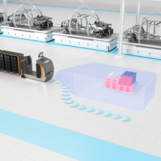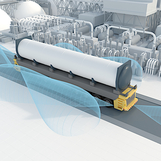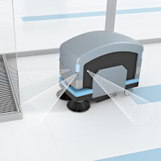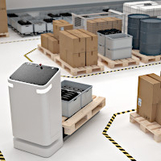Environment Perception

Whether in logistics centers, on factory premises, or in office buildings—AGVs must accurately detect their environment at all times in order to avoid collisions with people and objects.
This requires the use of special technologies. Pepperl+Fuchs offers unique sensors and systems for this purpose, such as the USi-safety safe ultrasonic sensor system with safety approval according to ISO 13849-1 category 3 to PL d or the R2300 3-D LiDAR sensor with the highest angular resolution in its class. These and other sensors allow precise and reliable environmental perception and ensure flawless processes when using AGVs.
Solutions for Collision Avoidance

To avoid collisions, AGVs must reliably detect the distances and contours of objects in their environment. For this purpose, the SmartRunner Explorer 3-D vision sensor generates high-resolution 3-D point clouds. These form the basis for three-dimensional maps from which the controller determines a collision-free route.

Safe use of heavy-duty AGVs in outdoor areas places special demands on sensor technology. The dimensions of the vehicles and the associated large monitoring area must be taken into account, as well as weather influences. Radar sensors from Pepperl+Fuchs are ideally suited for this task, as they are not very susceptible to interferences caused by rain, fog, wind or dust while at the same time offering a detection range of more than 25 meters.

During order picking operations, small-scale vehicles such as bots are used to transport the required racks through the logistics center. The R2300 3-D LiDAR sensor supports the navigation of these autonomous vehicles and provides reliable protection against collisions. With its high angular resolution, it delivers precise environment detection that enables AGVs to lift and safely transport racks from the warehouse to the picking station.

Self-propelled cleaning robots are often used in office buildings and shopping centers. They detect obstacles automatically and drive around them. However, some obstacles such as doors and walls made of glass are difficult for optical sensors to detect. Therefore, ultrasonic sensors of the 30GM or L2 series, for example, are used to reliably detect objects—regardless of their optical properties as well as dirt, ambient, and weather conditions.
Solutions for Personnel Protection

To ensure that people are protected from collisions in all directions of travel during material transports with AGVs such as automated forklifts, the vehicles must be safeguarded in accordance with ISO 13849-1 category 3 to PL d. The USi-safety is the only ultrasonic sensor system in the world to have this safety approval. It enables reliable monitoring of three-dimensional spaces.

In the chemical industry, tanks with a length of up to 20 meters are moved around the factory premises with correspondingly large driverless industrial trucks. However, long tanks require a respectively large radius when cornering. Therefore, the side areas of the AGVs in particular must be monitored to avoid collisions with people during cornering. For this task, several USi-safety ultrasonic sensors are distributed along the flanks to detect all obstacles within a defined safety zone. The ultrasonic sensor system is insensitive to ambient conditions and is therefore also suitable for outdoor use.







 +45 7010 4210
+45 7010 4210